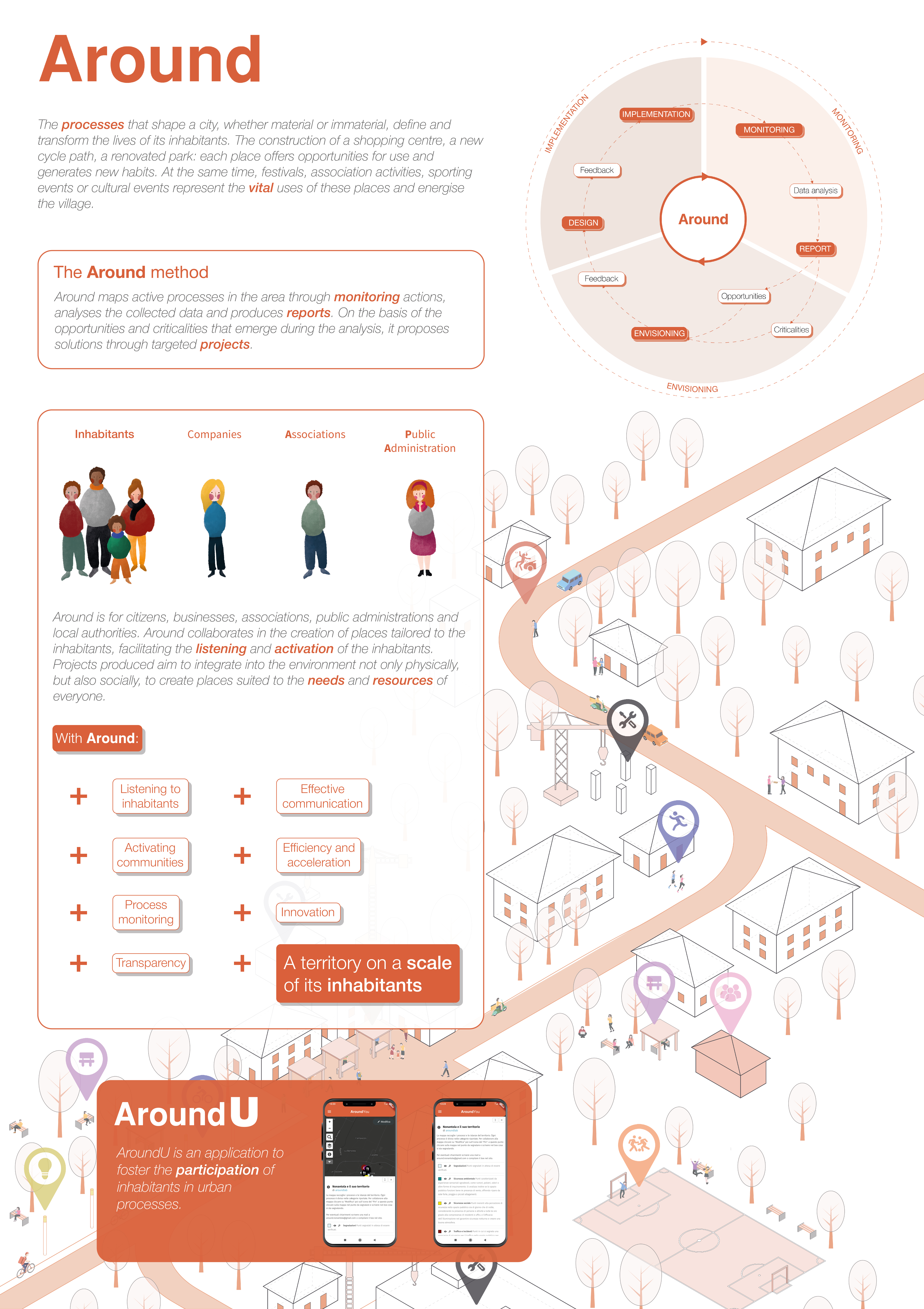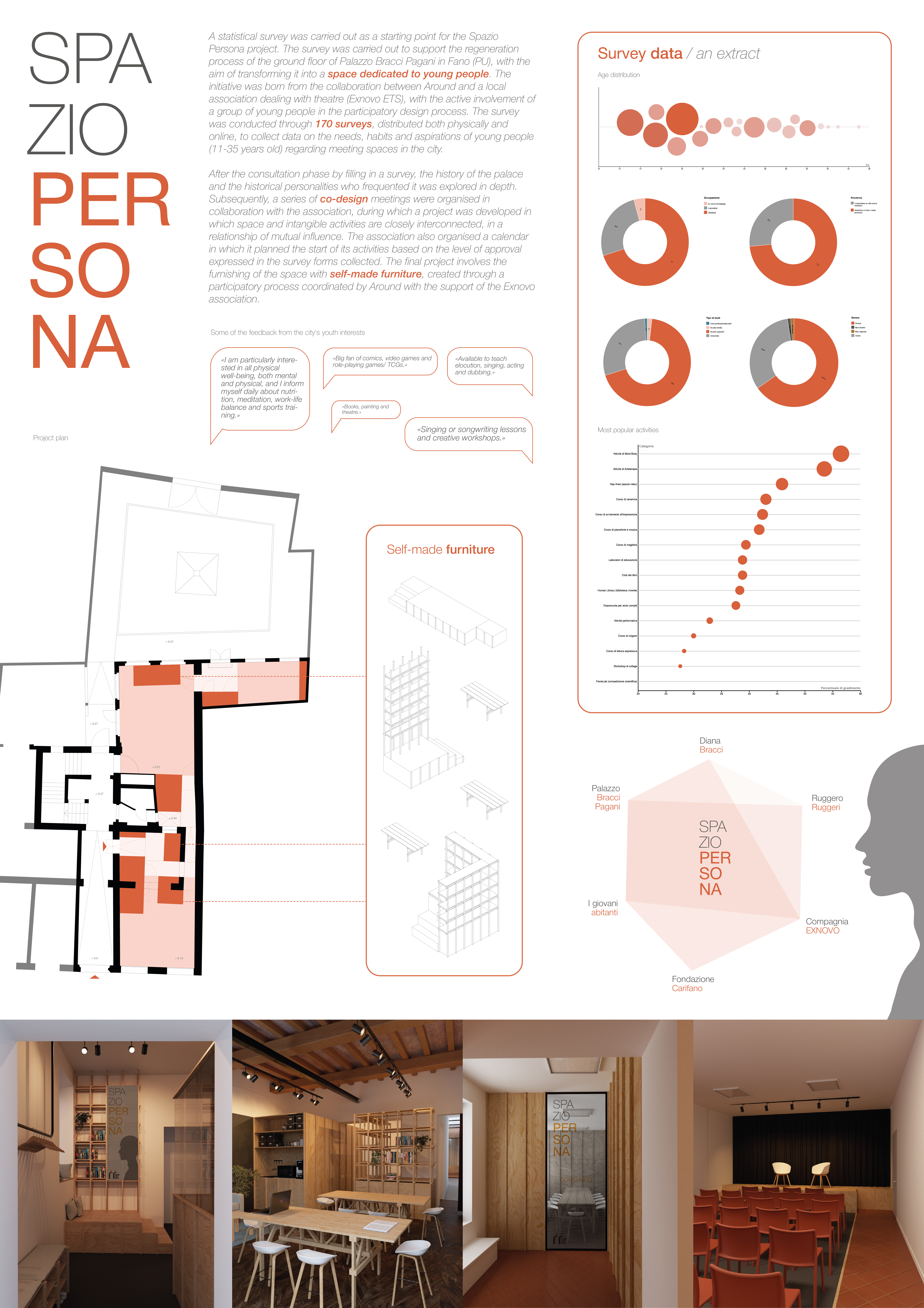Prioritising the places and people that need it the most
Around
Around promotes territorial co-creation, collecting data and fostering participation.
Around Project is an initiative that promotes territorial observation and co-creation through data collection and active participation of local communities. By integrating citizen science, the project allows citizens to contribute to the analysis of urban processes, raising awareness of the changes taking place and fostering social inclusion. The focus is on collaboration and direct involvement of inhabitants, to develop shared solutions that improve the quality of urban life.
Italy
Local
Around is a method that can be applied at different scales. For now, it has been tested in the cities of Fano (PU) and Nonantola (MO).
It addresses urban-rural linkages
It refers to other types of transformations (soft investment)
Prototype level
No
No
As an individual
Around is a participatory urban regeneration project that aims to improve the quality of life of vulnerable communities through the creative and sustainable reuse of public spaces. The project involves local residents in the design and implementation of transformations, prioritising social inclusiveness and ecological sustainability. The main objective is to create environments that meet the concrete needs of the community, reinforcing the sense of belonging and fostering collaboration between different local realities. The results obtained include the creation of redeveloped spaces, the implementation of ecological solutions and the activation of participatory processes that have improved social cohesion and community resilience. In this context, the project directly responds to the category ‘Prioritising places and people who need it most’, as it focuses on urban areas in need of social and ecological regeneration, with a focus on inclusiveness, accessibility and sustainability. The success of the project is reflected in increased active community participation and a heightened sense of shared responsibility for caring for the environment and enhancing local resources.
Urban regeneration
Participation
Inclusivity
Sustainability
Citizen Science
The Around project aligns with the New European Bauhaus core values of sustainability, inclusion, and aesthetics. Its sustainability objective focuses on regenerating urban spaces by fostering community participation in monitoring and observing local environments. This approach promotes the circular economy by encouraging the reuse of existing urban spaces and the sustainable management of resources. Through community-driven data collection and the creation of spaces that bridge the gap between natural and built environments, Around highlights the importance of responsible urban development and ecological balance.
By actively involving local residents in these processes, Around also prioritizes social inclusion, ensuring that marginalized groups and individuals benefit from the transformation of their neighborhoods. The project's design considers accessibility and affordability, while its aesthetic approach integrates local heritage and community-driven cultural expression.
Through these combined efforts, Around exemplifies how urban regeneration can contribute to both environmental sustainability and social cohesion. The project provides a model for sustainable, inclusive, and aesthetically enriching urban transformation, encouraging citizens to engage with and shape the development of their own spaces. This participatory approach fosters a deep connection to the environment, ensuring long-term impact and enhancing quality of life for all community members.
By actively involving local residents in these processes, Around also prioritizes social inclusion, ensuring that marginalized groups and individuals benefit from the transformation of their neighborhoods. The project's design considers accessibility and affordability, while its aesthetic approach integrates local heritage and community-driven cultural expression.
Through these combined efforts, Around exemplifies how urban regeneration can contribute to both environmental sustainability and social cohesion. The project provides a model for sustainable, inclusive, and aesthetically enriching urban transformation, encouraging citizens to engage with and shape the development of their own spaces. This participatory approach fosters a deep connection to the environment, ensuring long-term impact and enhancing quality of life for all community members.
Around enhances the aesthetic value of contemporary neighborhoods by focusing on the informal urban fabric, a key aspect of its research. By engaging directly with the communities, the project aims to bring out an authentic, contextually appropriate aesthetic, one that resonates with the residents' identity and cultural roots. The design approach prioritizes local materials, craftsmanship, and unique expressions of the community, ensuring that the transformation is not only functional but also deeply connected to the local context. This approach fosters a more sustainable, inclusive, and visually meaningful environment, enhancing both the quality of experience for people and the visual identity of the neighborhood. Through the processes initiated by Around, residents play an active role in shaping the aesthetic landscape, which helps to forge a sense of belonging and ownership. This model can serve as an exemplary case for creating environments that are both visually appealing and culturally rooted, demonstrating how urban regeneration can enhance both the physical and cultural fabric of neighborhoods.
Around focuses on creating an inclusive urban environment by listening to the needs and resources of the community. Every resident has the opportunity to voice their opinions and demand changes, empowering individuals and groups to contribute to the transformation of their neighborhoods. Through participatory processes, the project ensures that all voices are heard, fostering a sense of ownership and shared responsibility. By actively involving citizens in decision-making, Around promotes equal access to resources and opportunities, exemplifying a model for inclusive governance. It emphasizes social equality and supports a more equitable and just urban environment, where everyone, regardless of background or circumstance, can contribute to shaping their living spaces. The project is also designed to accommodate different needs, ensuring accessibility, affordability, and cultural relevance. This participatory model stands as an example of how inclusive design principles can be applied to create socially cohesive and sustainable urban spaces.
Around promotes citizen engagement by involving the community in every phase of the project, ensuring that the needs and voices of the people shape the outcome. A concrete example of this is the project carried out in Fano, where the Carifano Foundation launched a competition for a new youth space in the historic city center. Around, in collaboration with a local association, administered a questionnaire to a representative sample of young people in the city, collecting valuable data on their needs and resources. Based on this, the team proposed a project tailored to both the identified needs of the youth and the activities suggested by the association. This collaborative approach led to a solution that truly reflected the desires and requirements of the young people, ensuring the space would be meaningful and beneficial for the community.
By giving citizens an active role in shaping their environment, Around not only fosters a sense of ownership but also builds trust and solidarity within the community. This participatory model is exemplary in the context of inclusive governance and design, as it highlights the importance of listening to and valuing the input of all stakeholders. It also ensures that the solutions provided are both practical and aligned with the community's values and aspirations.
By giving citizens an active role in shaping their environment, Around not only fosters a sense of ownership but also builds trust and solidarity within the community. This participatory model is exemplary in the context of inclusive governance and design, as it highlights the importance of listening to and valuing the input of all stakeholders. It also ensures that the solutions provided are both practical and aligned with the community's values and aspirations.
Around engages various stakeholders to ensure the project's success. Locally, it works with community members and organizations to gather insights and address needs. In Fano, for instance, the collaboration with a local association and young people helped tailor the project to their specific needs. While Around collaborates regionally with entities such as the Carifano Foundation, its efforts also align with broader national and European initiatives. These collaborations enrich the project by bringing together diverse expertise, ensuring sustainability and inclusivity, and enhancing its relevance at all levels.
Around involved a wide range of professionals to ensure that the project was well structured and met the real needs of the community. In collaboration with local associations, direct involvement of citizens was promoted, gathering their needs and resources. Alongside architects and town planners, they worked to develop solutions that combined local needs with technical expertise. Participation experts coordinated the process, ensuring that the voices of the community were effectively heard and integrated into the project, thus creating a more inclusive and focused project. The synergy between these different disciplines enriched the process, providing added value that enhanced the relevance and impact of the project.
Around is innovative because it disrupts traditional urban planning by placing local communities at the center of the design process. Rather than following a top-down model, the project fosters collaboration between citizens, professionals, and local associations. This approach empowers residents to voice their needs and desires, ensuring that interventions are deeply relevant to the context. By integrating knowledge from multiple fields—such as architecture, urban planning, and community engagement—Around creates more adaptable, inclusive, and sustainable solutions. The project’s flexibility in responding to evolving urban challenges sets it apart from mainstream approaches, which often overlook the nuanced needs of local populations.
The methodology of Around is grounded in participatory design, where community engagement is central to the process. The project follows a bottom-up approach, actively involving local residents, associations, and experts. It begins by gathering data on the community's needs and resources, using tools like surveys, workshops, and feedback sessions. The project is tailored to address local challenges and is flexible, allowing for adaptive strategies as the needs of the community evolve. This participatory process ensures that the interventions are relevant, sustainable, and truly reflect the desires of the people it serves.
The elements of the Around project that can be replicated or transferred to other places and contexts include its participatory methodology, which emphasizes community involvement through surveys, workshops, and feedback loops. This approach can be adopted in different urban settings, ensuring that the voices of the local population shape the outcomes. The technology used for data collection and mapping, such as the use of UMap for geospatial insights, is adaptable for other regions. The lessons learned in fostering collaboration between local associations, residents, and professionals can also be applied to other cities looking to engage their communities meaningfully in urban transformation processes.
The Around project addresses several global challenges by providing local solutions. It focuses on fostering community engagement, sustainable urban development, and inclusion. By utilizing participatory methods, it empowers local residents to actively contribute to the design of their spaces, ensuring that solutions are tailored to their needs. The project also emphasizes circular economy practices, enhancing local resource management, and promoting sustainability. Through these localized approaches, Around tackles issues like urban decay, social exclusion, and environmental impact, creating scalable models that can be replicated in other contexts.
Next steps for the Around project include further strengthening community involvement and collaboration with local organisations. During the coming year, the focus will be on refining the methodology for collecting citizen feedback and fostering local innovation. The project aims to consolidate partnerships with urban planners, architects and experts to develop more sustainable and tailored urban solutions. Around aims to increase its visibility and create a replicable model in other cities to address common challenges such as social inclusion and urban regeneration. Around has also already developed a prototype AroundU app to stimulate the collection of urban data in a bottom-up system.


